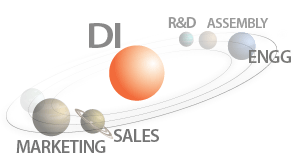
Digital Infrastructure (DI) lies at the core of digital transformations of economies and businesses.
In a naive way it may be compared to the computer operating system (OS). Users do not use it directly, but it drives such popular applications like Microsoft Word, Excel, PowerPoint and, of course, Internet Explorer.
In manufacturing, applications belong to business processes; when chained they create value - product or service. So DI is an OS for a business. It may be manufacturing of original equipment or engineering services. But DI makes big step forward: it connects the processes into a whole one and shares the data between all the parts. Connectivity adds to business transparency and agility – two goods in hysterical demand today.
Next big thing is that DI adds structure to a business: it links the processes in an optimal way to maximize the each one and the whole business outcomes. Links are alive: they are continuously re-validated.
The DI optimization skills have another interesting application: process health monitoring. Is the process out of normal boundaries? An example is monitoring the information credibility.
In other words, DI knows about business more than any other person in the company. DI is the modern know-how. To work with DI you do not need to sign NDA – non-disclosure agreement. The DI enormity and diversity makes it impossible for some hacker to stole, decipher, and maintain it.
Any other person may be a process engineer, or control, or mechanical one, or project manager. DI represents any discipline as a set of data structures, algorithms, and business rules.
DI breaks the boundaries between disciplines. In that respect, any new technology like forward osmosis, or advanced desalination, or ZLD, or brine treatment are but plugins into DI. In other words, no new non-digital technology may succeed without DI.
Recent example is Oasys, a mono-technology company. After nine years and $70M of funding, it has ceased commercial operations. "The company evolved from an initial ambition to be a desalination company, to latterly being focused on brine management and ZLD" (BlueTech Research).
DI is the company window to the outer world. It takes care of search engine optimization (SEO), website activities analysis, marketing campaigns and e-advertising.
DI maintains business relationships with outer world as well: it tracks vendors and suppliers, the clients' feedback, follows promising startups, and participates in knowledge sharing.
The above-mentioned definition of DI extends far beyond the compound business space of such product groups as PLM, ERP, project tracking, business process management, knowledge-sharing and data-mining technologies.
When coupled with business automation, DI migration brings about tremendous increase in business productivity, quality and agility never imagined before. Vision is needed to leverage these powers. Migration is try-and-error and unique process of business re-birth. Data transparency, knowledge sharing, and online feedback are new categories waiting for interpretation. One of the unexpected results of DI is the business diversification and new business models coming in naturally. Total cost of DI ownership (TCCO) cannot be forecasted.
DI is not only about moving the x86 processing loads to some cloud provider; it requires new fundamental abstractions and wider generalizations. For example, digtized engineering does not use simple integer or double values. Instead, they are replaced for multi-dimensional structure containing information about accuracy, possible range, validation rules, metric system, its source or traceability data and others.
As Big Data repository, DI shall be a synonym of Data Categorization, Validation, Traceability, and Unification. Systems Engineering canons shall be built into DI. DI shall enforce Concurrent Virtual Engineering driven by Business Process Management implementation.
DI shall accelerate the turn from "how to model the process" to "how to remotely interact with this process", how to embrace Internet-Of-Things.
DI building experience matters, and it is not sharable. The experience gained is the best know-how ever, historical data (so-called "use cases") are equally important.
DI requires significant time and resources. Surveys show that on the average only 10% of processing loads are annually moved to DI in leading companies today. Complete re-programming of the people mindsets may take even more time.
